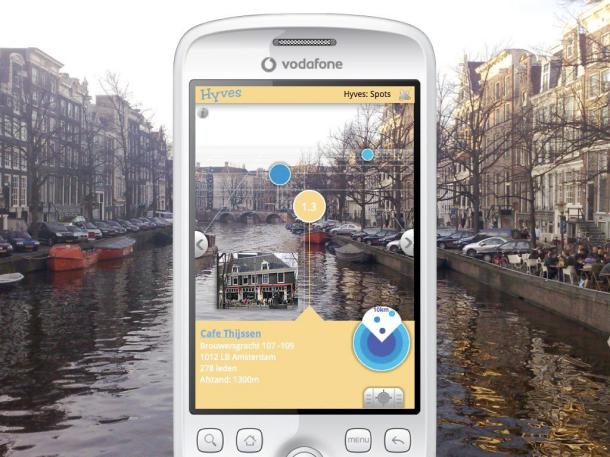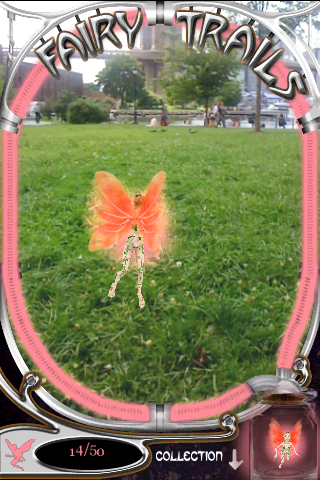- Cell phones such as the iPhone 3gs have built in GPS, the kind that reads signals directly from satellites to tell your position on Earth's surface. The iPhone also has a little known magnetometer, or compass built in. Swing the hand that is holding the phone around quickly, it knows which way you are facing. Very quickly.
- Cell phones have built in cameras. You hold the phone up in front of you and you get a live camera image like a video camera.
- Cell phones accept video goggles. Video goggles, most resembling sunglasses, some wireless via Bluetooth, overlay what is on your phone's screen with reality. Video goggles also have tiny cameras that can replace the phone camera.
- Cell phones interact with the 3G internet network.
 Only on the Android phone in the Netherlands, SPRXmobile has created a travel app called "Layer" allowing users to tag points of interest at their actual location. Much like "layers" in Google Earth, photos, comments, etc appear in your line of vision if you hold up your phone in that direction. They are developing for iPhone. I imagine graffiti on buildings, or notes posted on restaurant front doors left by past patrons saying what to order, or to run away.
Only on the Android phone in the Netherlands, SPRXmobile has created a travel app called "Layer" allowing users to tag points of interest at their actual location. Much like "layers" in Google Earth, photos, comments, etc appear in your line of vision if you hold up your phone in that direction. They are developing for iPhone. I imagine graffiti on buildings, or notes posted on restaurant front doors left by past patrons saying what to order, or to run away. "Fairy Trails" , out for a few months now, by Freeverse, a maker of many fine iPhone apps, has a game where you walk around with your phone and catch fairies planted in the environment around you. I can only imagine this expanding to role playing or first person shooter games. Brace yourself for bands of goggled kids running around shooting imaginary foes in the mall.
"Fairy Trails" , out for a few months now, by Freeverse, a maker of many fine iPhone apps, has a game where you walk around with your phone and catch fairies planted in the environment around you. I can only imagine this expanding to role playing or first person shooter games. Brace yourself for bands of goggled kids running around shooting imaginary foes in the mall.A very exciting use of augmented reality is adaptation of the 2D bar code. You've seen these on some products you've bought. The more info given, the smaller the squares get in the design. For instance, my drivers license has a bar code that includes all the information on my card. Kimberly Spreen at Augmented Environments Lab at Georgia Tech, uses 2D bar code on playing cards to animate a virtual pet game. This could create augmented experiences for printed matter: magazines, brochures, newspapers, and cereal boxes. I imagine you could put a 2D bar code on your building that would trigger an augmented experience for cell phone users. Here's a demonstration of Kimberly's amazing work:
It's not too hard to see what is coming from this. Imagine most people having these video enabled digital sunglasses on. Imagine a virtual world, like Second Life, where augmented reality is already being used, that interfaces with the real world. You could have a real world meeting with virtual avatars attending. Everyone wearing goggles, remote participants would occupy real chairs in your conference room. Really exciting, probably years off in the future, but I love the idea of having a friend appear in front of me even though it's just a phone call.